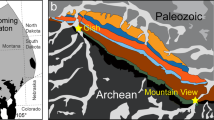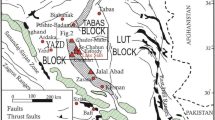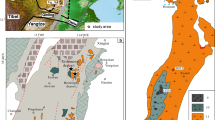Abstract
The evolved, iron-rich rocks of the tholeiitic Bushveld and Skaergaard intrusions are similar in containing cumulus magnetite, ilmenite, plagioclase, clinopyroxene, apatite and olivine, and also orthopyroxenes/pigeonite in Bushveld. Here, we evaluate their liquid evolution trends using the total iron content in plagioclase determined by electron microprobe analyses. To aid this analysis a revised mass balance model for the liquid evolution of Skaergaard is presented. For plagioclase in the Upper Zone of Skaergaard it was previously demonstrated that total FeO increases from ~0.25 to ~0.45 wt% with differentiation and correlates inversely with An% [100 × Ca/(Na + Ca)]. The reverse trend is observed in two recently published datasets for Bushveld, showing that total FeO in plagioclase decreases upward through the magnetite-bearing Upper Zone from ~0.30 to ~0.15% and from ~0.40 to ~0.25% in the western and northern limbs, respectively, and correlates positively with An%. The partition coefficient of total iron between plagioclase and magma increases with oxidation and polymerisation in the liquid. Although Bushveld formed under slightly more oxidizing conditions than Skaergaard, differences in the partition coefficients cannot explain the two observed trends. We therefore conclude that the differentiation trends of the liquids subsequent to magnetite saturation were fundamentally different. The inferred liquid composition for Bushveld contained about 15 wt% total FeO at the level of magnetite-in, which is slightly less than the total FeO content of the subsequent cumulates. In contrast, the Skaergaard liquid contained more total FeO than the ensuing cumulates. As a result, in Bushveld residual liquids total FeO decreased after magnetite saturation, whereas in Skaergaard the residual liquids continued to become enriched in iron. This conclusion is corroborated by simple mass balance calculations between modelled residual liquids and extracted cumulate rocks. Despite the mineralogical similarities of evolved iron-rich rocks of Skaergaard and Bushveld, their liquid evolution trends were very different, and generalizations about the extent of iron enrichment in tholeiitic magmas should be avoided.









Similar content being viewed by others
References
Andersen JCO (2006) Postmagmatic sulphur loss in the Skaergaard intrusion: implications for the formation of the Platinova Reef. Lithos 92(1–2):198–221
Andreasen R, Peate DW, Brooks CK (2004) Magma plumbing systems in large igneous provinces: inference from cyclical variations in Palaeogene East Greenland basalts. Contrib Mineral Petrol 147:438–452
Ashwal LD, Webb SJ, Knoper MW (2005) Magmatic stratigraphy in the Bushveld northern lobe: continuous geophysical and mineralogical data from the 2950 m Bellevue drillcore. S Afr J Geol 108:199–232
Brooks CK, Nielsen TFD (1978) Early stages in the differentiation of the Skaergaard magma as revealed by a closely related suite of dike rocks. Lithos 11:1–13
Buddington AF, Lindsley DH (1964) Iron–titanium oxide minerals and synthetic equivalents. J Petrol 5:310–357
Candela PA (1986) The evolution of aqueous vapor from silicate melts: effect on oxygen fugacity. Geochim Cosmochim Acta 50:1205–1211
Cawthorn RG (2005) Pressure fluctuations and the formation of the PGE-rich Merensky and chromitite reefs, Bushveld Complex. Min Deposita 40:231–235
Cawthorn RG, Molyneux TG (1986) Vanadiferous magnetite deposits of the Bushveld Complex. In: Anhaeusser CR, Maske S (eds) Mineral deposits of South Africa, vol I and II. Geological Society of South Africa, Johannesburg, pp 1251–1266
Cawthorn RG, Walraven F (1998) Emplacement and crystallization time for the Bushveld Complex. J Petrol 39:1669–1687
Cawthorn RG, Webb SJ (2001) Connectivity between the western and eastern limbs of the Bushveld Complex. Tectonophysics 330:195–209
Cawthorn RG, Meyer PS, Kruger FJ (1991) Major addition of magma at the Pyroxenite Marker in the western Bushveld Complex, South Africa. J Petrol 32:739–763
Frost BR, Lindsley DH (1992) Equilibria among FeTi oxides, pyroxenes, olivine, and quartz: part II. Application. Am Min 77:1004–1020
Grove TL, Baker MB, Kinzler RJ (1984) Coupled CaAl–NaSi diffusion in plagioclase feldspar: experiments and application to cooling rate speedometry. Geochim Cosmochim Acta 48:2113–2121
Hanghøj K, Rosing MT, Brooks CK (1995) Evolution of the Skaergaard magma: evidence from crystallized melt inclusions. Contrib Mineral Petrol 120:265–269
Hoover JD (1989) Petrology of the Marginal Border Series of the Skaergaard intrusion. J Petrol 30:399–439
Humphreys MCS (2009) Chemical evolution of intercumulus liquid, as recorded in plagioclase overgrowth rims from the Skaergaard intrusion. J Petrol 50:127–145
Jakobsen JK, Veksler IV, Tegner C, Brooks CK (2005) Immiscible iron- and silica-rich melts in basalt petrogenesis documented in the Skaergaard intrusion. Geology 33(11):885–888
Jakobsen JK, Tegner C, Brooks CK, Kent AJR, Lesher CE, Nielsen TFD, Wiedenbeck M (2009) Parental magma of the Skaergaard intrusion: constraints from melt inclusions in primitive troctolite autoliths and FG-1 dykes. Contrib Mineral Petrol. doi:10.1007/s00410-009-0416-3
Kruger FJ, Cawthorn RG, Walsh KL (1987) Strontium isotopic evidence against magma addition in the Upper Zone of the Bushveld Complex. Earth Planet Sci Lett 84:51–58
Larsen LM, Watt WS, Watt M (1989) Geology and petrology of the Lower Tertiary plateau basalts of the Scoresby Sund region, East Greenland. Geol Surv Greenland Bull 157:1–164
Lundgaard KL, Tegner C (2004) Partitioning of ferric and ferrous iron between plagioclase and silicate melt. Contrib Mineral Petrol 147(4):470–483
McBirney AR (1989) The Skaergaard layered series I: structures and average compositions. J Petrol 30(2):363–398
McBirney AR (1996) The Skaergaard intrusion. In: Cawthorn RG (ed) Layered intrusions. Developments in petrology, vol 15. Elsevier Science, Amsterdam, pp 147–180
McBirney AR (1998) Iron in plagioclase as a monitor of the differentiation of the Skaergaard intrusion: a discussion of Christian Tegner (Contrib Mineral Petrol 128:45–51). Contrib Mineral Petrol 132:103–105
Morse SA (1981) Kiglapait geochemistry IV: the major elements. Geochim Cosmochim Acta 45:461–479
Naslund HR (1984) Petrology of the Upper Border Series of the Skaergaard intrusion. J Petrol 25:185–212
Nielsen TFD (2004) The shape and volume of the Skaergaard intrusion: implications for mass balance and bulk composition. J Petrol 45:507–530
Osborn EF (1959) Role of oxygen pressure in the crystallization and differentiation of basaltic magma. Am J Sci 257:609–647
Phinney WC (1992) Partitioning coefficients for iron between plagioclase and basalt as a function of oxygen fugacity: implications for Archean and lunar anorthosites. Geochim Cosmochim Acta 56:1885–1895
Reynolds IM (1985) Contrasted mineralogy and textural relationships in the uppermost titaniferous magnetite layers of the Bushveld Complex in the Bierkraal area north of Rustenburg. Econ Geol 80:1027–1048
Smith JV, Brown WL (1987) Feldspar minerals. Springer, Heidelberg
Sparks RSJ, Huppert HE (1984) Density changes during the fractional crystallization of basaltic magmas: fluid dynamic implications. Contrib Mineral Petrol 85:300–309
Tegner C (1997) Iron in plagioclase as a monitor of the differentiation of the Skaergaard intrusion. Contrib Mineral Petrol 128(1):45–51
Tegner C, Lesher CE, Larsen LM, Watt WS (1998) Evidence from the rare-earth-element record of mantle melting for cooling of the Tertiary Iceland plume. Nature 395(6702):591–594
Tegner C, Cawthorn RG, Kruger FJ (2006) Cyclicity in the Main and Upper Zones of the Bushveld Complex, South Africa: crystallization from a zoned magma sheet. J Petrol 47(11):2257–2279
Tegner C, Thy P, Holness MB, Jakobsen JK, Lesher CE (2009) Differentiation and compaction in the Skaergaard intrusion. J Petrol 50:813–840
Thy P, Lesher CE, Nielsen TFD, Brooks CK (2006) Experimental constraints on the Skaergaard liquid line of descent. Lithos 92(1–2):154–180
Thy P, Lesher CE, Nielsen TFD, Brooks CK (2008) On the Skaergaard intrusion and forward modeling of its liquid line of descent: a reply to “Principles of applied experimental igneous petrology” by Morse 2008, Lithos 105:395–399. Lithos 105(3–4):401–411
Thy P, Lesher CE, Tegner C (2009) The Skaergaard liquid line of descent revisited. Contrib Mineral Petrol 157:735–747
Toplis MJ, Carroll MR (1995) An experimental study of the influence of oxygen fugacity on Fe-Ti oxide stability, phase relations, and mineral-melt equilibria in ferro-basaltic systems. J Petrol 36:1137–1170
Toplis MJ, Carroll MR (1996) Differentiation of ferro-basaltic magmas under conditions open and closed to oxygen: implications for the Skaergaard intrusion and other natural systems. J Petrol 37:837–858
Toplis MJ, Brown WL, Pupier E (2008) Plagioclase in the Skaergaard intrusion. Part 1: core and rim compositions in the layered series. Contrib Mineral Petrol 155:329–340
Veksler IV (2009) Extreme iron enrichment and liquid immiscibility in mafic intrusions: experimental evidence revisited. Lithos 111:72–82
Veksler IV, Dorfman AM, Borisov AA, Wirth R, Dingwell DB (2007) Liquid immiscibility and the evolution of basaltic magma. J Petrol 48(11):2187–2210
Veksler IV, Dorfman AM, Borisov AA, Wirth R, Dingwell DB (2008) Liquid immiscibility and evolution of basaltic magma: reply to S. A. Morse, A. R. McBirney and A. R. Philpotts. J Petrol 49(12):2177–2186
von Gruenewaldt G (1971) A petrological and mineralogical investigation of the Bushveld Complex in the Tauteshoogte–Roossenekal area of the Eastern Transvaal. D.Sc. thesis, University of Pretoria
Wager LR (1960) The major element variation of the layered series of the Skaergaard intrusion and a re-estimation of the average compositions of the hidden layered series and of the successive residual magmas. J Petrol 1:364–398
Wager LR, Brown GM (1968) Layered igneous rocks. Oliver & Boyd, London 588
Young DD (1998) N. L. Bowen and crystallization differentiation: the evolution of a theory. Mineralogical Society of America, Washington
Acknowledgments
This research was supported by grants from the Danish Natural Science Research Council and the National Research Foundation of South Africa and the Angloplats, Implats and Lonplats mining companies. The Council for Geosciences, South Africa, is thanked for access to bore core material and permission to publish. We thank Lew Ashwal, Peter Thy and Madeleine Humphreys for critical comments and discussions, Sidsel Grundvig for help with the electron microprobe, two anonymous referees for constructive reviews, and Jochen Hoefs for editorial handling.
Author information
Authors and Affiliations
Corresponding author
Additional information
Communicated by J. Hoefs.
Electronic supplementary material
Below is the link to the electronic supplementary material.
Rights and permissions
About this article
Cite this article
Tegner, C., Cawthorn, R.G. Iron in plagioclase in the Bushveld and Skaergaard intrusions: implications for iron contents in evolving basic magmas. Contrib Mineral Petrol 159, 719–730 (2010). https://doi.org/10.1007/s00410-009-0450-1
Received:
Accepted:
Published:
Issue Date:
DOI: https://doi.org/10.1007/s00410-009-0450-1




